A big February is now in the books
For investors in U.S. Equities, there were many sectors and market caps to grab extra returns. The tech and healthcare sectors were full of 20%+ movers during the month. Earnings and M&A were the main catalyst to stocks popping higher, but Earnings still sparked some of the February reports especially in the sectors of Consumer Cyclical and Technology…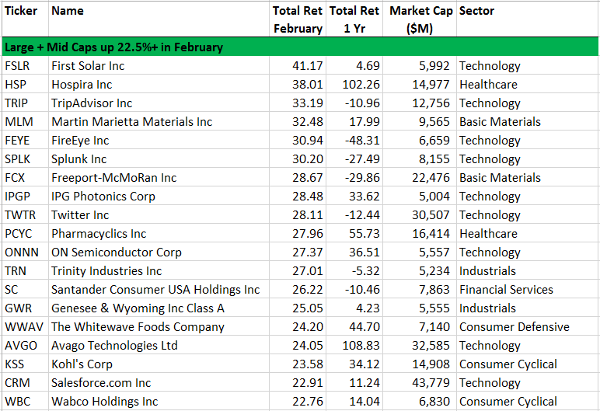
Even the $50b+ Mega Caps had a long list of 10%+ movers…
On the flip side of the ledger, the losing list was dominated by the safe sectors of Utilities and REITs…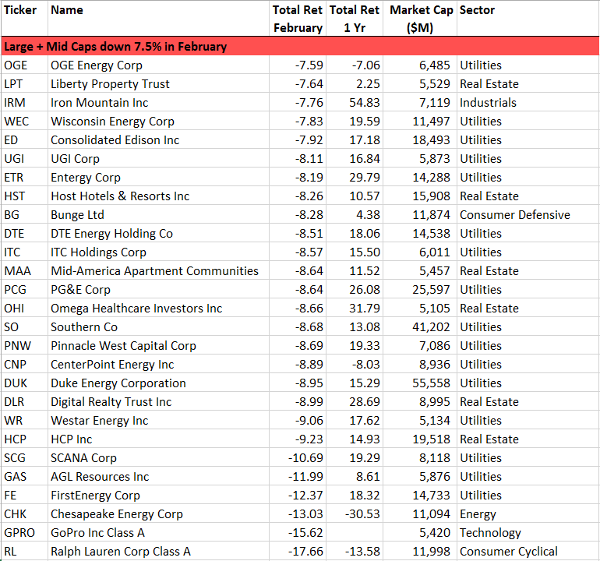
You could almost feel the Risk level fall with each day in February…
There really isn’t a lot to say about domestic markets other than that the landscape is extremely boring and (ostensibly) controversy-free. Several near-term obstacles and possible risk events have been overcome – Ukraine is observing a ceasefire, Greece struck a deal, earnings are done (and the Jan-end companies over the last few weeks looked a lot better than their Dec-end peers did back in Jan), the Fed won’t be hiking for the next several months (and Yellen effectively preannounced the removal of “patient” in Mar), eco data is improving in Europe (and remains decent in the US), Washington is fighting w/o reaching for the “nuclear” weapons (i.e. no full shutdowns or debt ceiling showdowns), the ECB is about to embark on QE, and oil has stabilized (neither Brent nor WTI has set a new low in weeks).
For the week, Consumer Cyclicals and Staples were the strongest sectors while Energy resumed to the downside…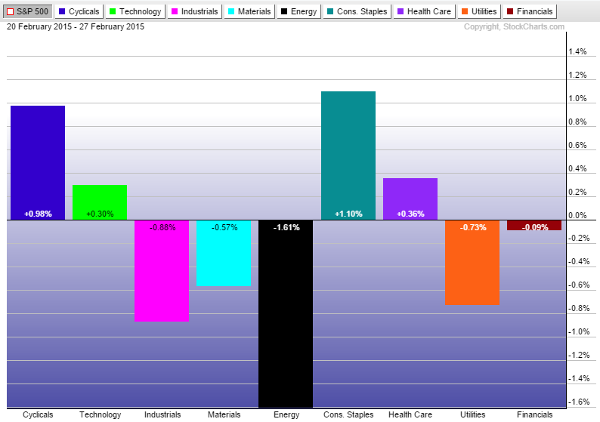
More broadly, Bonds and Europe joined in the weekly gains while the major U.S. Indexes ended flat…
Europe’s indexes are top performers year to date. And the % of Euro companies paying dividend yields > bonds continues to grow…
NickatFP: Share of European companies with div. yields > corp. bond yield
Speaking of low rates, Europeans are being surprised with negative borrow rates…
At first, Eva Christiansen barely noticed the number. Her bank called to say that Ms. Christiansen, a 36-year-old entrepreneur here, had been approved for a small-business loan. She whooped. She danced. A friend took pictures. “I think I was so happy I got the loan, I didn’t hear everything he said,” she recalled. And then she was told again about her interest rate. It was -0.0172 percent — less than zero. While there would be fees to pay, the bank would also pay interest to her. It was just a little over $1 a month, but still. These are strange times for European borrowers, as if a wormhole has opened up to a parallel universe where the usual rules of financial gravity are suspended
El Erian suggests these negative rates could line up some significant volatility in the future…
There are few analytical models, and even fewer historical examples, to help understand the broader economic, financial, political and social implications of all this — particularly for a global financial system based on the assumption of positive nominal rates. We are truly in unchartered waters. The ultra-low interest rate regime is likely to persist for now. In the medium-term, this historical and highly unusual phenomenon is likely to bring not just possible benefits for the European economy but also much higher risks of collateral damage and unintended consequences. Accentuated by the illusion of market liquidity, this is a world in which small adjustments in probabilities of future outcomes — if and when they occur — could result in sharp movements in asset prices.
Several large retailers reported last week, their conference call commentary was positive…
Most retailers seemed pretty happy with their holiday results:
- “Let me begin by saying that we had a terrific fourth quarter.” (TJX Companies Inc (NYSE:TJX))
- “We were very pleased with the level of transaction growth that we had in the quarter. Matter of fact, it was above what we had anticipated.” (Home Depot Inc (NYSE:HD))
- “Comparable sales growth turned out to be nearly double our original expectation” (Target Corporation (NYSE:TGT))
- “All lines of business were positive and all regions were positive.” (Kohl's Corporation (NYSE:KSS))
Something that is particularly positive: strength was driven by traffic:
- “Traffic, yes, we’ve been very happy with how traffic has picked up over the last couple of quarters.” (Ross Stores Inc (NASDAQ:ROST))
- “We’re extremely pleased to see the comp almost entirely driven by customer traffic.” (TJX)
- “We are also pleased that traffic was the primary driver of our fourth quarter growth” (TGT)
Wal-Mart (NYSE:WMT) isn’t the only large employer being forced to raise wages…
Wage growth is breaking out in an unexpected corner of the U.S. economy: the nation’s restaurants and bars. Food-service employment has surged since the recession ended nearly six years ago, growing twice as fast as overall payrolls. But those gains had largely failed to translate into better wages in the sector, until recently. Restaurant wages zoomed up to an annualized pace of more than 3% in the second half of last year from below a 1.5% pace in the first half of 2013, according to the Labor Department. Private-sector wages across the overall economy have grown at about a 2% pace for the past five years. Many restaurant owners are now scrambling to hire and retain workers, a potential precursor to widespread wage gains if it signals diminished slack in the labor market
As wages rise and energy prices fall, consumers’ wallets are thickening, and the restaurants love it. Check out that acceleration in Cracker Barrel’s traffic…
The highest end of the auto market would suggest that economic strength is being felt in every household…
Thanks to a bullish economy and a burgeoning crop of multi-millionaires all over the world, the handful of carmakers catering to the very richest have finally started to figure out that they have been drastically underestimating demand for six- and seven-figure vehicles. That realization has fueled a new generation of interesting machines whose eye-popping price tags have widened the ultra-premium market. At the moment, unlike in decades past, the fastest-selling products in the auto business are also the ones that cost the most.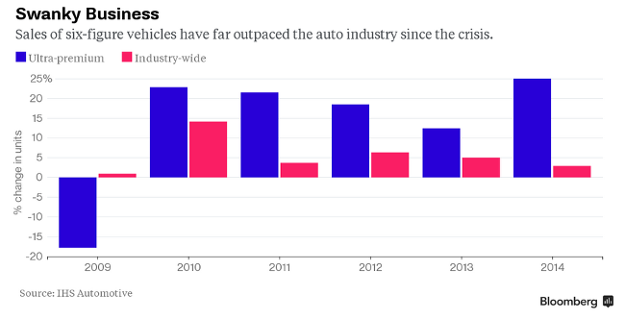
As the economy gets better, the Fed will need to react at some point. Lockhart’s comments here mimic Yellen’s Congressional testimony last week…
(U.S.) Fed’s Lockhart (moderate, FOMC voter): Must weigh weak inflation data against good growth and job gains; does not expect inflation to slow further – Reiterates all FOMC meetings from June onward are open to rate hikes, will support rate hike if evidence shows firming inflation- Fed not weighing rate rises just for rate hike’s sake- Has open mind about Fed’s ‘patient’ low rate pledge.
(TradeTheNews)
Falling energy prices have taken the CPI negative. Given the build in inventories last week, Consumers will continue to benefit…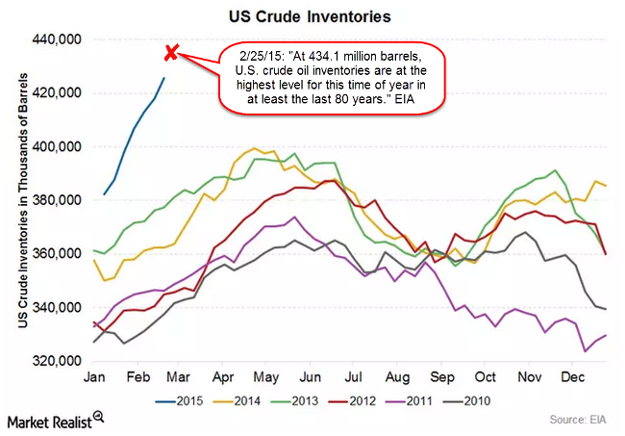
Energy concentrated economies are beginning to feel real pain…
The women hand out flyers for the accommodation in a desperate ploy to fill the $420-a-week rooms. “For two-and-a-half years my waiting list was so amazingly long that I didn’t even think about it,” said Mr. Jones. “Now here I am hustling.” The question on his lips is one being asked by many in south Texas and beyond: “What the hell just happened?” People in Carrizo Springs are nervous and the pain is likely to get worse. In recent weeks, they have begun to feel the economic shockwaves amid cuts enforced by the oil price slump — another jolt for a formerly sleepy town that was transformed with little warning in only a few short years into a bustling energy hub.
Retail investors have shifted Bond ownership to ETFs. But now the Institutions are shifting their books…
A host of factors is behind institutions’ adoption of bond ETFs, analysts say. Among them: Deteriorating liquidity in corporate bonds has frustrated large investors as many individual bonds have become difficult to buy or sell quickly at a given price, thanks in part to rules limiting banks’ risk-taking. U.S. corporate debt outstanding has grown by more than $2 trillion since the financial crisis to $7.7 trillion, but trading in many bonds has slowed as new rules caused dealers to pare their holdings by two-thirds from pre-crisis levels… Institutions’ growing adoption of bond ETFs could improve those funds’ performance and their ability to track baskets of bonds in a choppy market. Some of the popularity of ETFs may be coming at the expense of derivatives long seen as an attractive means of getting broad exposure to bonds. Average daily trading in U.S. index credit-default swaps has fallen to $5.3 billion this year from $8.5 billion a year earlier, according to Markit data.

And not just generic institutions, but also the top performing Hedge Funds are using ETFs to get their Bond exposure…
More and more, exchange-traded funds that invest in corporate debt are a playground for hedge funds. Take the oldest bond ETF, BlackRock Inc (NYSE:BLK).’s $21.7 billion investment-grade fund: Hutchin Hill Capital, a $3.2 billion manager, bought $431.4 million worth of shares in the last three months of the year. The position, more than 10 percent of Hutchin Hill’s assets, made the hedge-fund firm the ETF’s biggest buyer in the period, according to data compiled by Bloomberg based on regulatory filings.
State Street Corp (NYSE:STT).’s $4.1 billion short-term junk-bond ETF shows a similar picture, with Pine River Capital Management buying $196.8 million worth of shares. Why are hedge funds putting so much of their assets into ETFs? It’s an easier way to slip in and out of illiquid corporate debt as trading slumps relative to the market’s size.
Speaking of Debt, anyone interested in making all U.S. obligations disappear?
Now that is a cool Easter egg…
It’s not enough that Tesla’s Model S is the world’s best car, two years running — it’s also the coolest. A newly discovered Easter egg lets you turn your e-car into a Lotus Esprit S1 submersible. Hold the “T” logo, enter “007″ into the login, and then adjust your suspension to a depth of 20,000 leagues under the sea.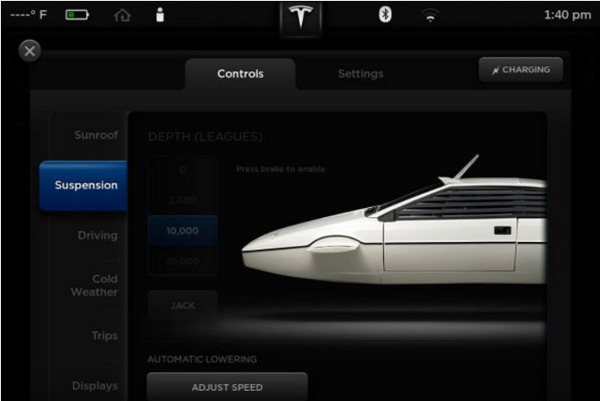
If you are studying Geek in College or High School and planning your next move, scout out these Cities…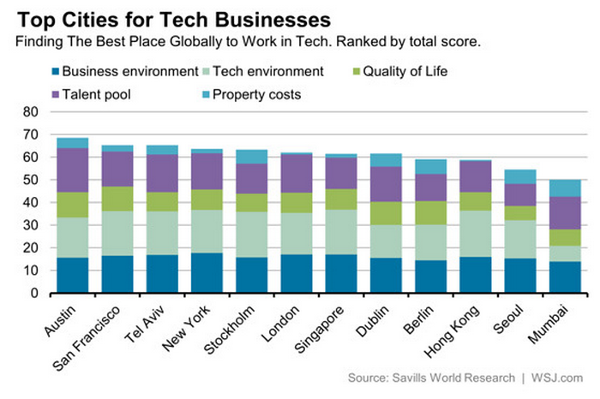
Disclosure: The information presented here is for informational purposes only, and this document is not to be construed as an offer to sell, or the solicitation of an offer to buy, securities. Some investments are not suitable for all investors, and there can be no assurance that any investment strategy will be successful. The hyperlinks included in this message provide direct access to other Internet resources, including Web sites. While we believe this information to be from reliable sources, 361 Capital is not responsible for the accuracy or content of information contained in these sites. Although we make every effort to ensure these links are accurate, up to date and relevant, we cannot take responsibility for pages maintained by external providers. The views expressed by these external providers on their own Web pages or on external sites they link to are not necessarily those of 361 Capital.
